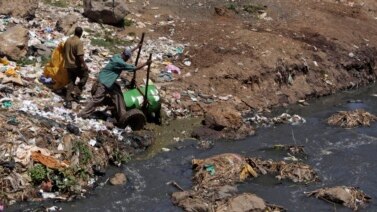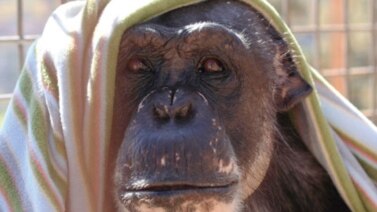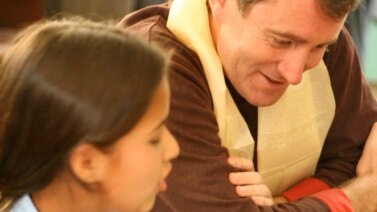
Hello again, and welcome. I’m Jim Tedder in Washington. On today’s program …something serious, and then something fun. First we travel to South Africa to examine the fight against HIV and AIDS in young people. The latest research shows that some developments are good, while others are not so good. We will hear from several experts who will give us their opinions on what needs to be done.
Then, as we approach the end of the year, we look back to one of our very first As It Is programs, and hear from some of our friendly, furry, friends who have been trained to do something special.
Listen carefully, and before you realize it, you have improved your American English by listening to As It Is.
There is good news to report from recent research on efforts to reduce new HIV infections among South African teens: The efforts are working. But there is also some bad news from the research, as well: girls between the ages of 15 to 24 are three times more likely than boys to get HIV.
The South African government says more people are getting tested for HIV because of a government campaign that urges teens to, in its words, “Get wise, get tested, get circumcised.”
President Jacob Zuma supported the campaign when he was publicly tested for HIV in 2010. He did not have the virus.
The United Nations says more than 6 million people in South Africa are living with HIV. But the Human Science Research Council of South Africa says HIV infections in people 15 to 24 years old has dropped from over 10 percent in 2005 to 7 percent in 2012.
Scott Burnett is a Senior Executive Manager at LoveLife. The organization is trying to eliminate HIV. He says the government’s campaigns have caused the decline in the HIV infection rate.
“Sex is far most spoken about, condoms are generally available, and people are beginning to realize that open, honest and early discussion about sex and sexuality don’t predispose young people to all the risk -- they actually help them to avoid risk.”
But girls remain more at risk than boys for being infected. The United Nations Childrens Fund says HIV infections among girls is at 13.6 percent. For boys it is 4.5 percent.
Matebogo Mampani is a training specialist at SoulCity. She knows why the infection rate is different. She blames it on the lack of HIV awareness messages targeted to young girls.
“Sometimes you find that in the schools people wanna say abstain (from sex) -- abstain when basically there are children in the same school who are pregnant, there are condoms that are used lying around in the schools.”
Nineteen-year-old Portia Munguambe is a Lovelife peer educator. She says there are other pressures that girls must face. She says girls living in poverty are having sex with older men because the men give them gifts, money and even food. These older men are called “sugar daddies.”
“Basically we have the issue of sugar mammies and sugar daddies. You know, as teens we wanna fit into the lifestyle of having fancy things, for example having my hair done, having those heels (high heel shoes).”
Portia Munguambe says increasing the self-esteem and confidence of young girls will help solve the problem. But she says girls must be responsible for their own health.
“Be safe, condomize and do everything with your powers to protect yourself.”
Ms. Munguambe says teenagers must be trained to give HIV information to their fellow teens. She says unless that happens, it will be a long time before the rate of HIV infections among young girls declines.
That Is One Smart Doggie!
It has been almost one year since the first As It Is program was broadcast and put on the Internet. One story in particular has gotten a lot of response from people around the world. So just for old time’s sake, we thought you might like to hear it again.
This dog is on a treasure hunt. And I think he has just found something.
“Yes! Yes, you found it. Yeah! Yeah! Always trust your dog.”
But what he has found (his name is “Boston”; he is a black Labrador) is not gold, or silver, or diamonds. What he has found is a white truffle, and he found it by using his nose.

Truffles are a kind of mushroom. They are used by the chief cooks in expensive restaurants. Food made with truffles usually costs a lot. In France, some people use pigs to search for truffles. While the truffles are in the ground, often near the roots of trees, they are hard for a human to smell. But pigs …and now dogs…seem to be especially good at finding them.
“Find it.”
Boston, and fifteen other dogs, are learning how to find truffles on a farm in the northwestern state of Oregon. Their owners have paid 600 dollars for the class. That may seem like a lot of money. But truffles can sell for hundreds of dollars per kilogram in markets.
If you do not have a dog, or a pig, you can search for truffles by yourself. Some people gently dig around in the forest with a rake. But this sometimes brings up a truffle that is not ready.
“By the time you disturb them, if they aren’t ripe, you can’t put them back. They are just never going to ripen, and that’s just kind of how that is.”
So the trainers say it is best to teach your dog to find truffles, even if it does take up to a year for some dogs to learn how to do it right.
“It’s easy to teach a dog the truffle scent and to find it. The hard part is teaching the dog to tell you when he’s found it, not to eat it when he’s found it, to keep working for an hour or two.”
And once he or she has found it, what does a truffle smell like, or taste like? Well, it’s hard to say. It may taste like a nut, or smell like a pine tree. Others say it tastes like a pineapple, or chocolate, or even …dirt.
Truffle experts think the northwestern United States is great place to search for these expensive and unusual foods. And where there are truffles, there is a growing need for …you know who!
(MUSIC)
I’m Jim Tedder in Washington. Thank you for spending some time with us and listening to As It Is. More Learning English programs are just seconds away, and there is world news at the beginning of the hour, on VOA.





